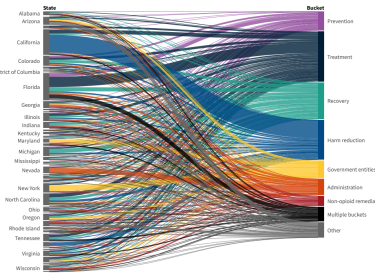
Addiction News Round Up: 6/14/19
Federal Grants Restricted to Fighting Opioids Miss the Mark, States Say, NPR
The federal government has doled out at least $2.4 billion in state grants since 2017, in hopes of stemming an opioid epidemic that killed 47,600 people in the U.S. in that year alone.
But state officials note that drug [misuse] problems seldom involve only one substance. And while local officials are grateful for the funding, the grants can be spent only on creating solutions to combat opioids, such as prescription OxyContin, heroin and fentanyl.
According to the most recent data from the Centers for Disease Control and Prevention, 11 states — including California, Pennsylvania and Texas — have reported that opioids were involved in fewer than half of their total drug overdose deaths in 2017.
Also, the federal cash infusion is guaranteed for only a few years, which throws the sustainability of the states' efforts into question. Drug policy specialists say the money may not be adequate to improve the mental health care system. And more focus is needed on answering the underlying question of why so many Americans struggle with drug addiction, they say.
Expert Witness: Johnson & Johnson's Role in Opioid Crisis May Be 'Worse' Than Purdue's, CNN
One of the nation's top experts on opioid addiction said Tuesday that Johnson & Johnson's role in the current epidemic may be even "worse" than that of Purdue Pharma, the maker of OxyContin.
Dr. Andrew Kolodny, the co-director of the Opioid Policy Research Collaborative at Brandeis University, made the comments during the 11th day of the historic trial in Oklahoma that is aimed at holding Johnson & Johnson and its subsidiaries responsible for the state's opioid epidemic.
"Until I had an opportunity to review discovery documents," Kolodny testified, "I really was not aware of how bad Johnson & Johnson was." He added, "I think that is probably true for many people."
So much media attention has focused on the role that Purdue -- and its powerful owners, the Sackler family -- played in the nation's opioid crisis, Kolodny said, that Johnson & Johnson had largely escaped public scrutiny.
The Van Vs. An Opioid Addiction: Taking Treatment to The Streets, WBUR
The Care Zone team pairs veteran outreach workers with a doctor and a case manager. Ribeiro and Mackin, veteran street workers, typically make the first contact with an occupied sleeping bag. Dr. Jessie Gaeta, chief medical officer with the Boston Health Care for the Homeless Program, approaches once it’s clear that a new face won’t send the person back into hiding. She knows many of these prospective patients feel shunned by mainstream medicine.
"We’re trying to let people know we’re not there to arrest them. We’re not there to clean up their encampment and kick them out," Gaeta says. "All we want to know is, do we have something you need and want, and if we do, great, here it is. And so we gradually build a relationship that way."
LGBTQ+ Youth Prefer to Seek Mental Health Help Digitally, Wired
LGBTQ+ youth are particularly vulnerable to mental health crises and suicide, and society hasn't found enough ways to assist them. Even as acceptance for queer people is seemingly on the rise, social conditions are leading to dire mental health outcomes. And the political discourse in the US isn't helping—76 percent of the youth surveyed said the current climate was affecting their mental well-being. "There is not something about being LGBTQ that is leading to mental health and suicide disparities, it's the way that LGBTQ youth are treated and stigmatized," says Amy Green, the director of research at the Trevor Project, who oversaw the survey.
That stigmatization comes from friends, family, health care professionals, and the culture at large. The survey asked kids whether they were out to an adult at school, and found that less than half were. Young people were most likely to have disclosed their sexual orientation or gender identity to an LGBTQ+ friend, and more than half disclosed to their parents.
Inside the Elementary School Where Drug Addiction Sets the Curriculum, The New York Times
Inside an elementary school classroom decorated with colorful floor mats, art supplies and building blocks, a little boy named Riley talked quietly with a teacher about how he had watched his mother take “knockout pills” and had seen his father [inject drugs] “a thousand times.”
Riley, who is 9 years old, described how he had often been left alone to care for his baby brother while his parents were somewhere else getting high. Beginning when he was about 5, he would heat up meals of fries, chicken nuggets and spaghetti rings in the microwave for himself and his brother, he said. “That was all I knew how to make,” Riley said.
Riley — who is in foster care and who officials asked not be fully identified because of his age — is among hundreds of students enrolled in the local school district who have witnessed drug use at home. Like many of his classmates at Minford Elementary School, Riley struggles with behavioral and psychological problems that make it difficult to focus, school officials said, let alone absorb lessons.




